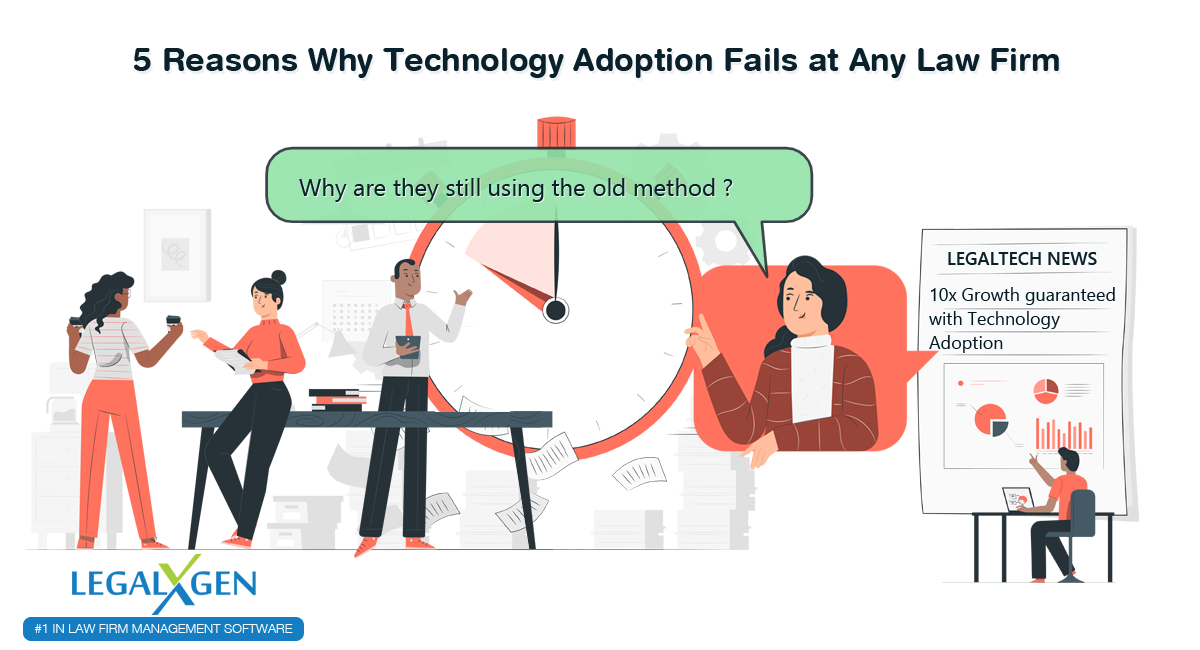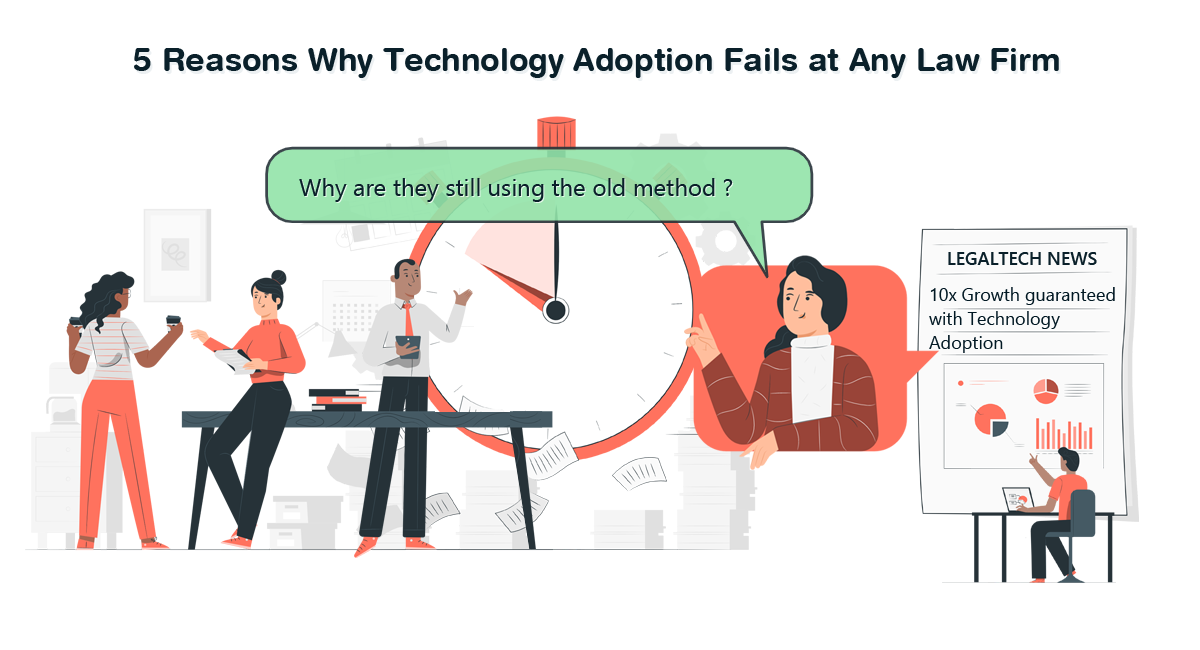

Do you ever wonder why industries change, how they adapt, and, most importantly, how they feel about the change?
You’re probably wondering why I’m bothering you with this.
Let me give you some figures: only one-third of attorneys (34%) believe their firms are well-prepared to keep up with technological advances in the legal business, even though existing technology can automate 23% of lawyer work.
Well! To comprehend why technology adoption fails in law firms, it is necessary to first understand what technology adoption is and why is it important.
In layman’s terms, we can simply state technology adoption as the successful integration of new technology into one’s business. It is the key to getting the most out of your investment. The company becomes more productive; users accomplish more in less time and a noticeable boost in the workforce’s output are a few advantages of technology adoption.
So, regardless of the sort of business, you’re probably thinking that it needs to adapt to technological developments as soon as possible, right? That isn’t how easy it is for anyone to feel.
To be honest, technology adoption appears to be simple. However, anyone who has gone through a software rollout or digital transformation programme knows how challenging it is to get any firm to adopt new technologies.
And it is undeniable that it is even more difficult when it comes to our law firms.
Following are the top 5 reasons why technology adoption fails at any law firm. Let’s take a closer look at these:
- Resistance:
When it comes to technology adoption people from the not technical background has simple apprehension, that it’s something too complex and going to add some extra burden. Which is not true.
But yes, you need to ensure the technology you are selecting should be easy to use. Many times, technology solutions extend its feature in a too complex manner. That impacts the adoption considering the busy schedule of any lawyer.
Also, another major reason for the problem is the nature of the industry, which favours seniority (experienced lawyers who are quite old) and it is found that usually, elderly’s brains are resistant to change, and so technology adoption is a no for law firms.
- Lack of trust/ confidence with technology:
Technology poses’ risk of one form or another and there is always some risk when a firm tries to incorporate new technology. Lawyers are bound by ethical obligations to their clients, thus being on the “bleeding edge” of technology is exceedingly risky. No lawyer wants to risk a malpractice action or an ethics complaint because something “broke” by using untested technology.
In a 2019 study, 10.26% of respondents said their law business had some form of a security breach, 50% mentioned worries about confidentiality and security, 36% cited loss of control, and 19% blamed the expense of switching.
Employees at law firms believe their manual procedure is quite efficient. And their processes are just too complicated for any technology solution to handle. They adhere to the same traditional method and are unwilling to adopt technology when it comes to changing their working style, which is equally efficient. However, adopting some unfamiliar technology demands courage to step out of one’s comfort zone and invest time to learn and train their staff.
- Lack of process enforcement by top management:
Managers must recognise their role in developing organisational ethics and take this chance to foster an environment that can improve the relationships and reputations that are critical to their firms’ success.
Also, it is a good practice to maintain a complementary tone of conduct within the hierarchy of the organization as it provides transparency, openness and commitment to continuous improvement which are vital for organizational development as a whole.
From providing extra resources to giving words of encouragement or when customers complain about slow networks, unstable software, or unclear instructions, or any other technical difficulties faced by them a true leader does not make technology optional.
Executives who ignore this in today’s increasingly harsh legal environment risk personal and organisational consequences. And to our surprise digital transformation is not a choice for around 30% of senior executives at companies; it is only a matter of survival, according to them. On the contrary, 60% of lawyers say their firm is prepared to implement new technologies for everyday activities.
- Lack of training:
According to research, people forget 70% of what they learn in a training session. If your users can’t recall what they’ve learnt, even the best training and onboarding programmes won’t guarantee a high retention rate.
What methods do you employ to find out how your users are coping with new technology? How do you keep track of your technology adoption as a whole? Most businesses undergoing digital transformation struggle with measurement, tracking, and analysis.
To overcome all of these issues and increase user onboarding and adoption, you may invest in an ERP system that will help you streamline your technology. It is also a good idea to conduct frequent staff assessments to ensure that your investment in technology adoption is paying off.
- Poor support:
The final pitfall for individuals adopting technology for their law practice is insufficient post-purchase support, which is frequently admitted by customers. The easiest approach to avoid this is to walk through the entire process with the technology vendor when evaluating options.
A built-in feedback mechanism from users can also provide useful information and help eliminate false positives. Because no one can ever guarantee that there won’t be any technical issues post-installation, we can’t say no to technology because of the aforementioned reasons.
If you want to be successful when implementing new technology, you must plan for, identify, and address implementation challenges early on, as well as gain buy-in and commitment for technology – driving engagement, enhancing efficiencies, and improving user adoption and most crucial, the courage to take a chance and step outside of one’s comfort zone – allows you to maximise your return on investment. Otherwise, your technology will be nothing more than a costly instrument that no one will utilise efficiently.
Schedule a demo today to see if LegalXGen’s solution might be a good fit for your firm.

Market Research Analyst with a Master’s in Marketing and Analytical Experience.
 English
English French
French German
German